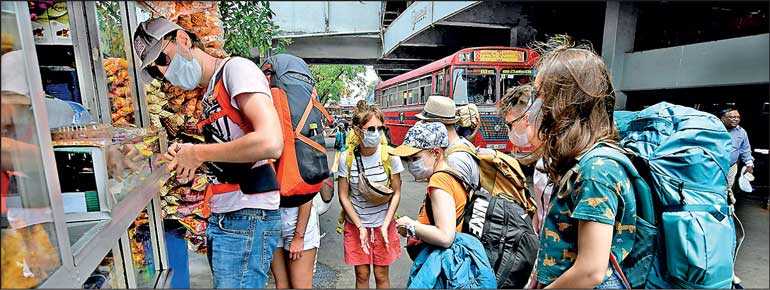Tuesday Apr 23, 2024
Tuesday Apr 23, 2024
Wednesday, 15 July 2020 00:00 - - {{hitsCtrl.values.hits}}

With the relaxation of lockdown, normalcy is slowly being restored. Product manufacturers, service providers, sales operations personnel and sites construction workers have recommenced their  activities. Modes of transportations are gradually getting back to functioning. The wish of everybody in general is to see that they can get back to their usual life styles soon, which was lost overnight for a period of nearly three months.
activities. Modes of transportations are gradually getting back to functioning. The wish of everybody in general is to see that they can get back to their usual life styles soon, which was lost overnight for a period of nearly three months.
The lockdown forced people to change their habits. Is this change temporary or long lasting? Looking back at crisis situations in our country from the past, the tendency is that we forget things very fast. In a way it is good because then we are geared to bounce back quicker. However, in this instance we have to be cautiously conscious because the threat created by this invisible virus is ever-present.
With the beginning of business activities, first and foremost, give customers the assurance that you are genuinely concerned about their convenience and safety. Your customers are your community. Let them truly ‘feel’ that you are responding to the crisis and all the health precautions are being taken for their safety.
With the opening up of the market different buying behaviours can be envisaged. At this point of time however, it is difficult to precisely predict the post-COVID-19 buying behaviour of the customers. Nevertheless, the four types of anticipated customer segments can demonstrate either radical or conservative behaviour. Regardless of the segment to which they belong to, service providers can make a distinctly sustainable differentiation through the emotional connection only.
1. Capital investors
These consumers do not feel directly impacted by the pandemic and are not changing their spending habits. They may yet want to make capital investments. There can be investments in buying gold and jewellery. A few will be interested in purchasing apartments and lands.
Increased demand for high branded new vehicles and unregistered imported vehicles can be observed. Procuring imported household electronic items are more likely to increase amongst them. This will happen with the customer anticipation that prices of such items will increase with possible economic policy and taxation changes in the near future.
2. Preservers
There can be another customer segment who wants to protect what they have. With the limited investment possible they will maintain just an acceptable level of life styles. They will maintain their existing vehicles by replacing the essential spare parts, enhance capacities of their existing computers, repair the malfunctioning electronic household items or service them to put back to use.
They will carry out any family functions with the minimum number in attendance at their homes or visit restaurants only with family members. They will save whatever the money they have in a place where the highest security and yield is assured. Furthermore, they will want to treasure and continue business relationships with the companies that really cared for them in the crisis and genuinely provided some value.
3. The upstarts
Those who have lost employment and are struggling due to retrenchments and pay cuts, may think of starting something on their own. Such customers may need financial assistance or information to help start up their ventures.
4. Brand shifters
There can be a segment who is going to realise the value of locally produced items opposed to imported goods. This can be owing to the influence of an advertisement. Some may even think of moving from a branded item to a generic item with the perception that it serves the purpose as long as it is good enough.
This is an extremely cost-conscious segment who has to get used to a different lifestyle altogether that suits their limited earning capacity. Moreover, they can be a patriotic segment with the ‘let us go local now,’ mentality.
The above customer segments are a possible development as a result of the COVID-19 impact. Their emotions and behaviour may be different to what you have dealt with prior to the epidemic. Whether their behaviour is radical or conservative, we have to understand that they are stressed out because nobody can give a definite forecast on how exactly the world will be after this pandemic.
However, whatever the interactions such customers are going to have with the service providers, this is an opportunity to build back and grow the respective business and in turn increase the economic prosperity of the country.
Service providers have to plan how they are going to manage customer expectations of the above segments at every touch point. Memorable positive experiences are persistent. Put a genuine effort to meet your customers’ needs in this moment of heightened vulnerability and go that extra mile by passionately caring and creating value for them in some way or the other. The emotional nature of your action can generate a halo of positive brand affinity that will endure long after COVID-19 passes.
Case 1: ‘Gestures of consideration’ can be effective
An insurance company in the United Kingdom has proposed giving £110 million back to their car and van customers as part of a ‘Stay at Home Refund’. This £25 refund per customer is the company’s best estimate of the savings that they have made during the period. Therefore, they decided to automatically give this to all 4.4 million of their current customers by the end of May.
Although £25 refund per customer will be a low percentage of most people’s car insurance payments, the research carried out has shown that this ‘gesture of consideration’ during the COVID-19 crisis has gone a long way with customers. The insurance company’s customer satisfaction score has increased by 13.9 points in just four days amongst its existing customers.
The money spent on this activity may not have a long-term adverse impact to the company. It is very likely that their existing customers will remember this goodwill gesture when the time comes for the next policy renewal.
Learning outcome
During lockdown only a few vehicles were seen on the road. It led to a drastic reduction in accidents, and insurance claims. In the process this Insurance Company may have made profits more than projected levels. It was an admirable gesture on their part to share this saving with customers.
Furthermore, they have gone above and beyond to evoke gratitude from their customers which is a challenging task to achieve even in normal times. Doing such an act has demonstrated their genuineness in looking after the best interest of the customer especially during a crisis. Obviously, such customer experiences will influence them to be with the same service provider for a long period of time.
Case 2: Prioritise empathy over business
In the early part of June, just after the lockdown was relaxed, I received a call from the Manager of the Flavors Restaurant at Galadari Hotel Ajantha Warawita. I was informed that their restaurant is now open for lunch and dinner subject to curfew hours. Coincidentally, it was falling on our wedding anniversary day, so I informed the Manager about it and said that if the time permits, we will visit them for dinner. He said they are anxiously looking forward to our presence.
We visited the restaurant around 7:30 p.m. We were welcomed with the ‘Ayubowan’ gesture and a “happy wedding anniversary” wish. Although the staff were wearing masks and their usual smile was invisible, their positive ‘tone of voice’ and willingness to help through ‘body language’ created a lasting impression in our minds.
Furthermore, when we were ordering food, they assisted us to order limited variety and quantity that would just be enough for the consumption of the family. This helped us get the best value for money spent while minimising waste. At the end, they brought a complementary eggless cake, knowing our preference, allowing both of us to cut it and feed each other. It sounds like a very simple act for the hotel, but it is a big value creation to the customer. We left the hotel with an assurance to the staff that we will see them again soon. When I informed this goodwill gesture to the General Manager of the Galadari Hotel Sampath Siriwardena, he responded, “At this moment of time we treasure emotional connection with the guests more than an opportunity to do a mere business deal.”
Learning outcome
This is the best opportunity for service providers to show how much they truly care for their customers when they start patronising your services again. Initially shift from a selling culture to a serving culture.
In the process if a significant value creation can be made to the customer with a little initiative on your part, embark on such activities promptly. At all levels everybody has a role to play and a common goal to achieve, which is building up a loyal customer base by creating a memorable experience for the customers.
Summary
In a crisis situation, when customers are trying to rebuild their lifestyles again, we must understand the fact that human interactions based on empathy is very important. Therefore, we must empathise first and sell second.
The poet Maya Angelou once explained, “I’ve learned that people will forget what you said, people will forget what you did, but people will never forget how you made them feel.”
(The writer is a sought after ‘service excellence’ specialist in Sri Lanka. Over the last 25 years he has conducted nearly 3,000 inspirational and educational programs for over 750 organisations in 11 countries. His work can be seen at www.dhammikakalapuge.com)